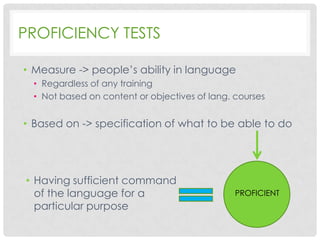Kinds of tests and testing
- 1. KINDS OF TESTS AND TESTING PAOLA ENRÍQUEZ D. 2.10.13
- 2. OUTLINE • Tests according to the information they provide • Proficienccy tests • Achievement tests • Diagnostic tests • Placement tests • Direct VS. Indirect testing • Discrete point VS. Integrative testing • Norm-referenced VS. Criterion-referenced testing • Objective VS. Subjective testing • Computer adaptive testing • Communicative language testing
- 3. PROFICIENCY TESTS • Measure -> people’s ability in language • Regardless of any training • Not based on content or objectives of lang. courses • Based on -> specification of what to be able to do ? PROFICIENT
- 4. PROFICIENCY TESTS • Measure -> people’s ability in language • Regardless of any training • Not based on content or objectives of lang. courses • Based on -> specification of what to be able to do • Having sufficient command of the language for a particular purpose PROFICIENT
- 5. PROFICIENCY TESTS • Measure -> people’s ability in language • Regardless of any training • Not based on content or objectives of lang. courses • Based on -> specification of what to be able to do • E.g. whether someone can function successfully as a UN translator. PROFICIENT
- 6. PROFICIENCY TESTS • Measure -> people’s ability in language • Regardless of any training • Not based on content or objectives of lang. courses • Based on -> specification of what to be able to do • Standard with respect to a set of abilities • No particular purpose for the language General PROFICIENT
- 7. PROFICIENCY TESTS • Measure -> people’s ability in language • Regardless of any training • Not based on content or objectives of lang. courses • Based on -> specification of what to be able to do • E.g. TOEFL, FCE, etc. General PROFICIENT
- 8. PROFICIENCY TESTS Not based on courses that candidates may have taken previously
- 9. ACHIEVEMENT TESTS • Related to language courses Final achievement tests Successful in achieving objectives Progress achievement tests
- 10. FINAL ACHIEVEMENT TESTS • At the end of the course of study • Content related to the course
- 11. FINAL ACHIEVEMENT TESTS • At the end of the course of study ? • Content related to the course Syllabus-content approach What if the syllabus was badly designed? Base it on the objectives • Compels course designers to be explicit about objectives • Performance on the test -> how far objectives have been achieved
- 12. PROGRESS ACHIEVEMENT TESTS • Formative assessment • Measure the Ss’ progress Objectives Short-term • ‘Pop quizzes’
- 13. DIAGNOSTIC TESTS • Identify learners’ strengths and weaknesses • What learning still needs to take place? PROFICIENCY TESTS • Few tests for purely diagnostic purposes
- 14. PLACEMENT TESTS • Place Ss at a stage (level) -> abilities • No placement test will work for every institution • Tailor-made -> constructed for particular situations
- 15. DIRECT VS INDIRECT TESTING Direct • The candidate performs exactly the skill being measured Indirect • Measure the abilities that underlie the skills
- 16. DIRECT VS INDIRECT TESTING Direct Indirect • Clear about the abilities to assess • Easier to construct • Test a sample of a finite number of abilities which underlie an indefinite number of manifestations of them
- 17. DIRECT VS INDIRECT TESTING Direct Indirect •Clear about the abilities to assess •Easier to construct •Results are more generalisable
- 18. DISCRETE POINT VS INTEGRATIVE TESTING Discrete Point Integrative • Testing one element at a time – item by item • Combination of many elements in the completion of a task
- 19. DISCRETE POINT VS INTEGRATIVE TESTING Discrete Point Integrative •e.g. •e.g.
- 20. NORM-REFERENCED VS CRITERIONREFERENCED TESTING NORMREFERENCED • Relates Ss’ performance to that of other Ss • Does not tell what the Ss are able to do CRITERIONREFERENCED • Shows what the Ss can actually do • Does not compare to other Ss’ performance
- 21. NORM-REFERENCED VS CRITERIONREFERENCED NORMREFERENCED CRITERIONREFERENCED • e.g. The S is in the top 10% of Ss who took the test. • e.g. The S is able to greet, to exchange information on personal background, home, school life and interests
- 22. OBJECTIVE VS SUBJECTIVE TESTING • Methods of scoring OBJECTIVE • No judgement required for scoring • Greater reliability • Easier to agree when more than one scorer • Judgement called for scoring SUBJECTIVE
- 23. COMPUTER ADAPTIVE TESTING ITEM OF AVERAGE DIFFICULTY MORE DIFFICULT ITEM MORE DIFFICULT EASIER EASIER ITEM MORE DIFFICULT EASIER
- 24. COMMUNICATIVE LANGUAGE TESTING • Ability to take part in acts of communication http://www.youtube.com/watch?v=DeFjGWp_8v0
- 25. REFERENCE • Hughes, Arthur. Testing for Language Teachers. New York: Cambridge UP, 2003.

























